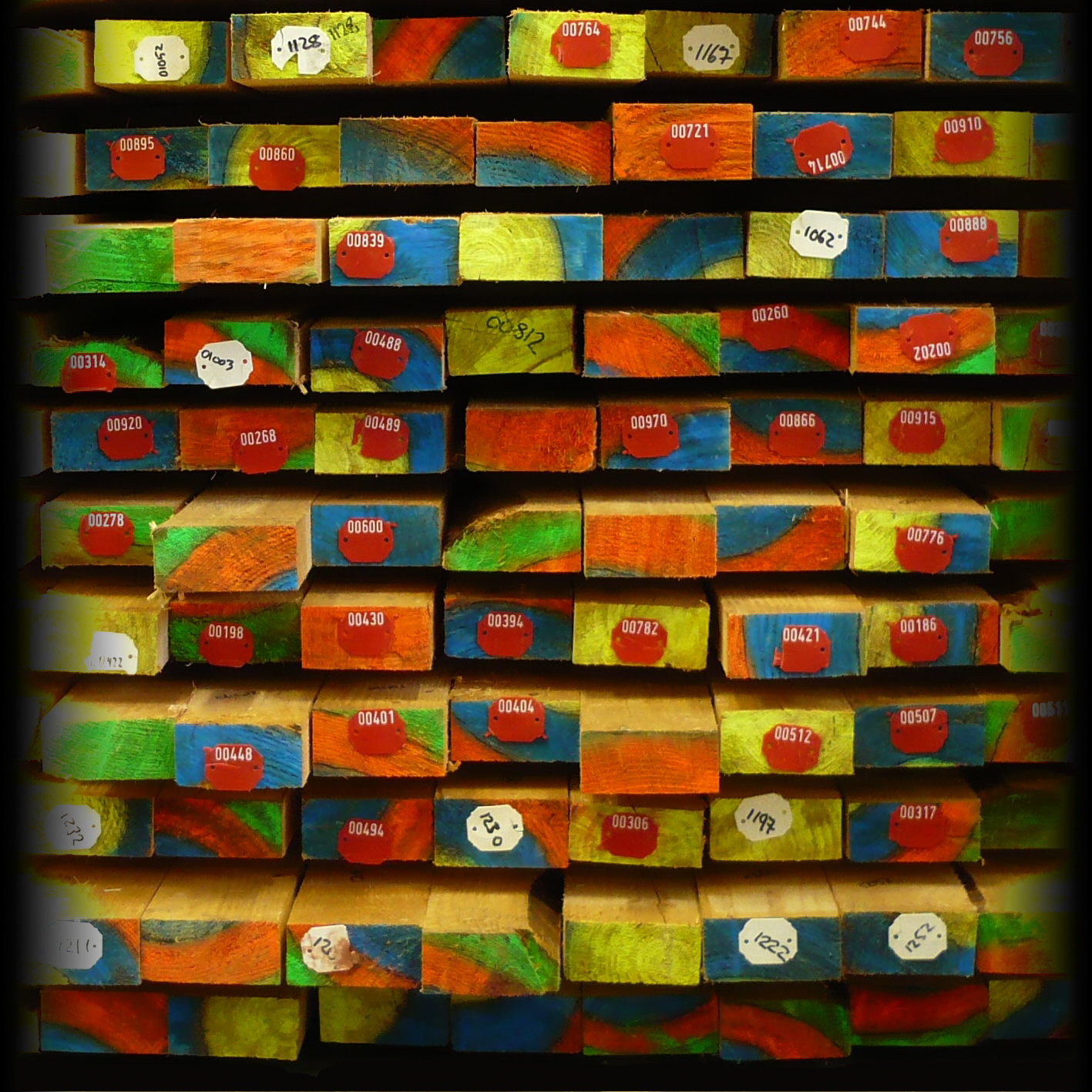
In a previous post “Grade in Britain” we said that “rate of growth”, as a concept in timber grading, isn’t so closely linked to the rate at which the trees actually grow.
It’s commonly said that UK and Irish plantation timber “grow too quickly” and that the result is low density – by implication low strength – timber. This a myth – and it isn’t just held in the UK (Check out this myth busting post from Oregon State University in the USA).
This is important, so let’s look again at this.
True or false: wood from slow-grown trees is stronger than wood from fast-grown trees
Well – it’s definitely not always true. The annoyingly vague (but correct) answer is “it depends”.
Growth rate – for the forester
Firstly, we need to unpick what is meant by “slow-grown”. The obvious interpretation is that the trees are growing slowly. Foresters measure the rate at which trees grow in a few different ways, including:
- Rate of increase in height of the tree
- Rate of increase in diameter of the tree
- Rate of increase in cross-sectional area of the tree stem
- Rate of increase in volume of the tree
- Rate of increase in mass of the tree
- Rate of increase of stem area, volume or mass within an area of land
The diameter of a tree is typically measured at “breast height”, which is 1.3 m in the UK. The term used is “diameter at breast height“, which has the acronym DBH. This is a useful measurement because it describes the size of the largest diameter log when the tree is harvested – important information for the sawmill as sawmills can only handle logs up to a certain size.
The rate of increase in volume of the tree is useful for forest management, as it describes the rate at which new wood is being grown. The volume of a conifer stem is a function of the tree height and the DBH so it is a relatively easy quantity to estimate if you have good information about the typical taper of the tree stem (from “allometry“).
In the UK, foresters commonly describe rate of tree growth in terms of “yield class” (YC). This describes the rate of growth in volume terms per hectare of land – and so relates to the productive capacity of a forest. Specifically, yield classes are measured in cubic metres per hectare per year. The yield class depends on the site, the species, the spacing of the trees and whether there is thinning.
Now this isn’t describing the amount of new timber grown each year – trees don’t grow at the same rate at different ages. For a young tree, the amount of new growth increases every year, but eventually it reaches a maximum and then starts to decline.
The mean annual timber increment (MAI) is the volume at a specified reference age, divided by that age. The maximum mean annual increment is the highest value of MAI across all reference ages. This is the point at which the amount of timber is relevant because, at that point, the stand’s productivity begins to decline. Stands are typically harvested at, or before, maximum MAI is reached.
Example: a compartment that is said to belong to yield class 12, has a maximum mean annual timber increment of 12 m3 per hectare. So, at it’s most productive it will have produced 12 m3 per hectare for each year it has been growing.
The typical yield class for Sitka spruce in Great Britain is 14 but many sites are significantly more productive – achieving 16 to 20.
Rotation lengths of 35–45 years are typical for commercial stands. At this age, Sitka spruce growing at yield class 14 would typically reach a top height (mean height of the largest trees) of between 16 and 23 m. The diameter will depend considerably on the choice of initial spacing and the thinning regime, but would typically be between 25 and 40 cm. (See Moore 2011 for more information).
At this age, the core-wood (also known as juvenile wood) comprises a significant proportion of the volume of harvested log. Core-wood is normally produced when the cambium of a conifer is less than, roughly, 15 years old – and generally has poorer mechanical properties than wood formed when the cambium is older. It also has poorer dimensional stability, with a higher propensity to twist on drying.
Radial trends in wood properties
There is an overall trend in wood properties, in a conifer like Sitka spruce, from pith to bark that comes from changes in wood cell wall thickness, and microfibril angle (arrangement of cellulose within the wood cell wall), of the new wood laid down as the tree grows. This is related to the biomechanical needs of the tree. From our point of view, the timber quality may also improve due to the reduction in relative knot content. This means that timber that comes from the outside of the log, grown when the tree was older (and younger in the sense that the wood was more recently grown) has, generally speaking, better properties (applies overall, but not on individual pieces).
This was shown in a study of 83 year old Sitka spruce trees grown in Kielder Forest, northern England (See Moore, Lyon and Lehneke 2011). The radial positions 1,2,3 and 4 correspond, in this case, to bands of roughly 15 years. Radial position 1, is the core wood, and it has lower average stiffness (E0,mean) than positions 2, 3 and 4.
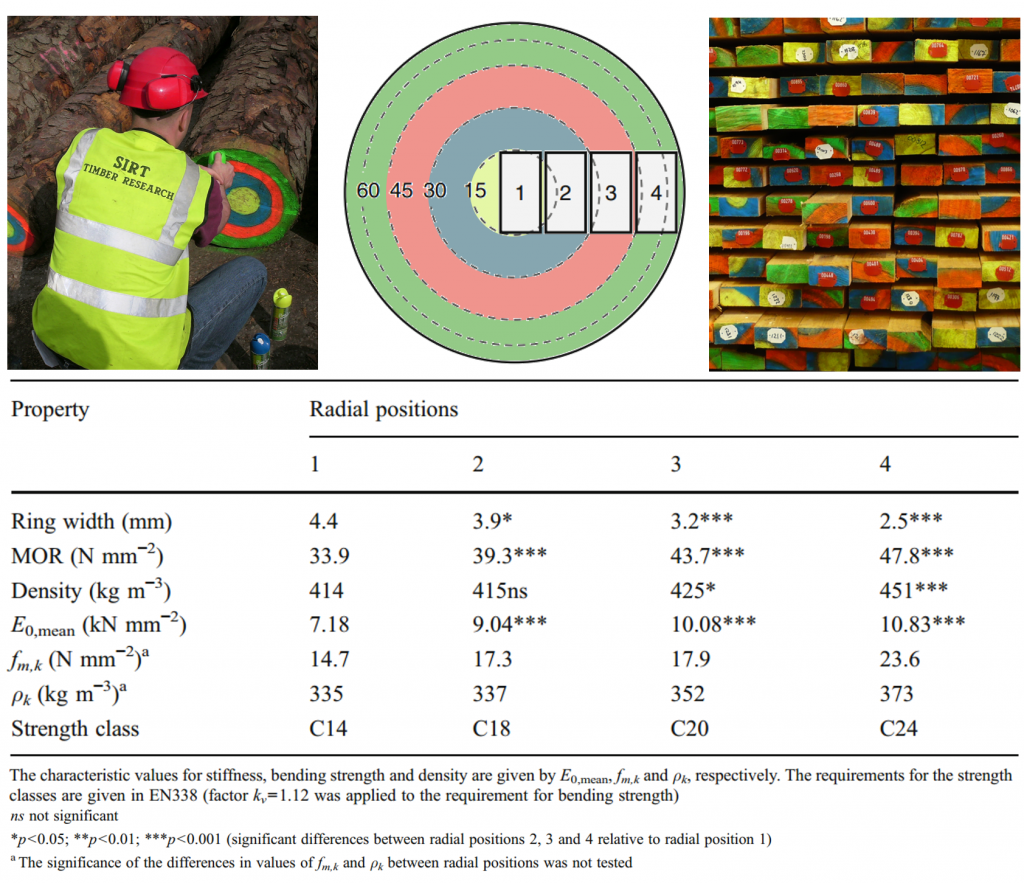
Whilst it appears that longer rotations will result in timber with improved mechanical properties and a lower propensity to distort, this is unlikely to be economic in the UK. The costs of growing the trees for an additional 35–40 years, and the increased risk of storm damage, is not offset by the difference in value of the different grades (C16 being perfectly adequate for typical construction use).
Rate of growth – for the grader
EN14081-1 requires that visual grading rules for softwoods and temperate hardwoods (ie those species that have clear annual rings) contain a requirement for either density or “rate of growth”. This concept of rate of growth is width of the ring (or inversely, the number of rings within a certain length – traditionally one inch).
It is important to realise that this definition of growth rate is not the same as the growth rate for the forester. The amount of new wood that a ring represents depends on the diameter of that ring. In the example below, a piece of timber sawn at at the location of the right-hand rectangle will have lower rate of growth than a piece sawn at the left-hand rectangle. Here, they both come from the same tree so for the forester, they are the same yield class.
Since the amount of new wood represented by a new ring increases as the tree ages, this concept of rate of growth is more of a proxy for radial position than it is for growth rate of the trees. In fact, a low rate of growth from a ring width point of view may actually be the point at which the tree was growing fastest (from a volume or cross-section area point of view).
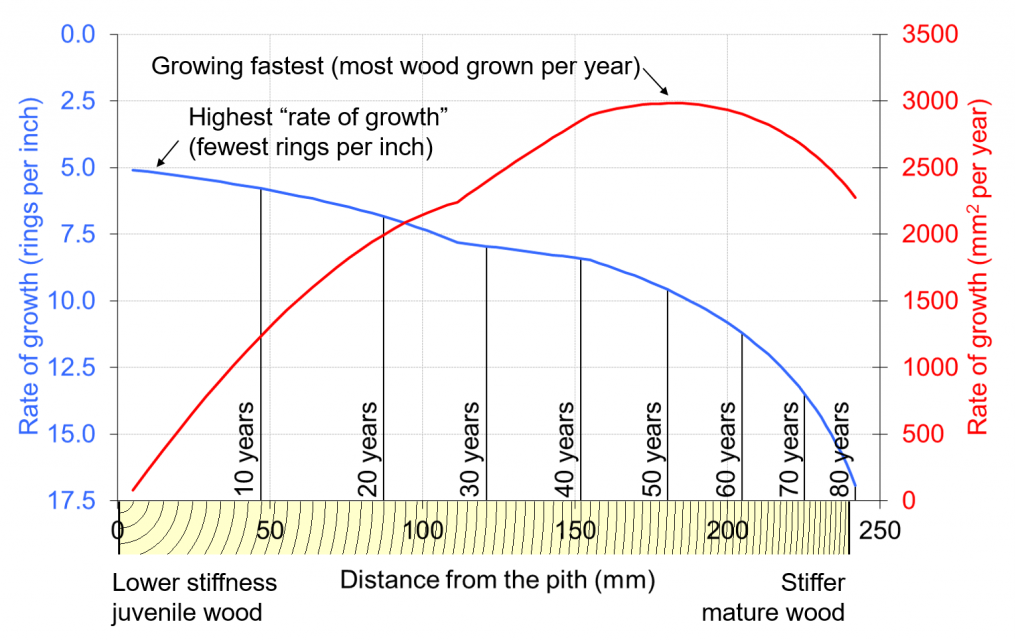
Knowing that wood further from the pith (in ring numbers) has better properties on average goes part of the way to explaining why this rate of growth is useful for grading timber. We should just not confuse this with rate of growth of the tree.
The clue to the main function of rate of growth is the statement in EN14081-1 that the visual grading rule needs to have either the rate of growth, or the density.
Actually, the rate of growth is intended to estimate density. It works in certain conifers because the amount of the denser latewood part of the ring is relatively constant – meaning that a wider ring has more of the less dense earlywood.
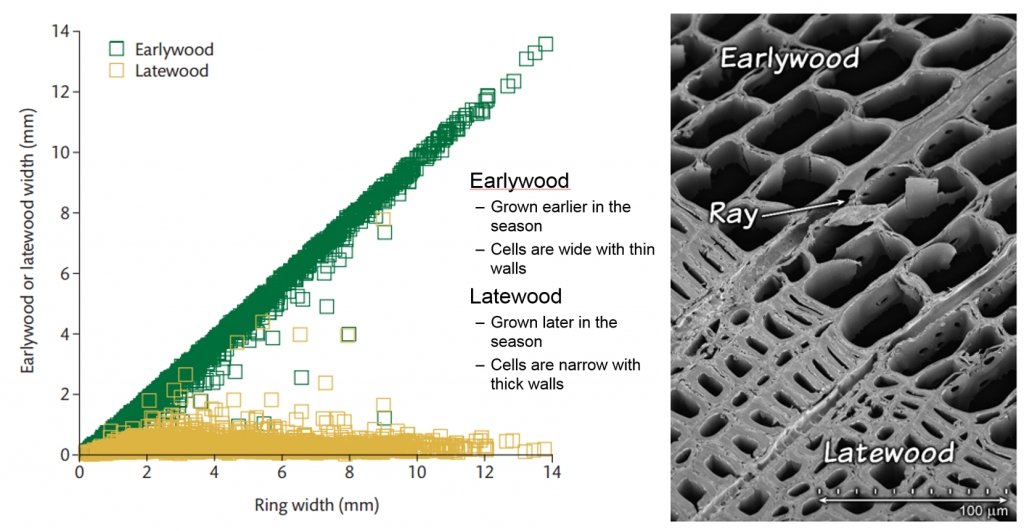
So a faster growing spruce tree grows more earlywood, relative to the amount of latewood, and so the timber is less dense (although correlation is quite weak), and typically less strong, as a result (although again, with weak correlation for normally sized pieces of timber). Density means more of the strength giving cell wall material in the wood, but simple density does not tell the whole picture, as it depends how the strength-giving material is arranged and composed – especially the arrangement of cellulose (“microfibril angle”) which is one of the things that changes with radial position. In Sitka spruce, the correlation between density and strength (or stiffness) of structural size timber is not very strong (partly due to it having a relatively dense juvenile core wood compared to other conifers) – and so density alone is not a good predictor of strength. This means that rate of growth as an estimate of density per se, isn’t very helpful as a predictor of strength.
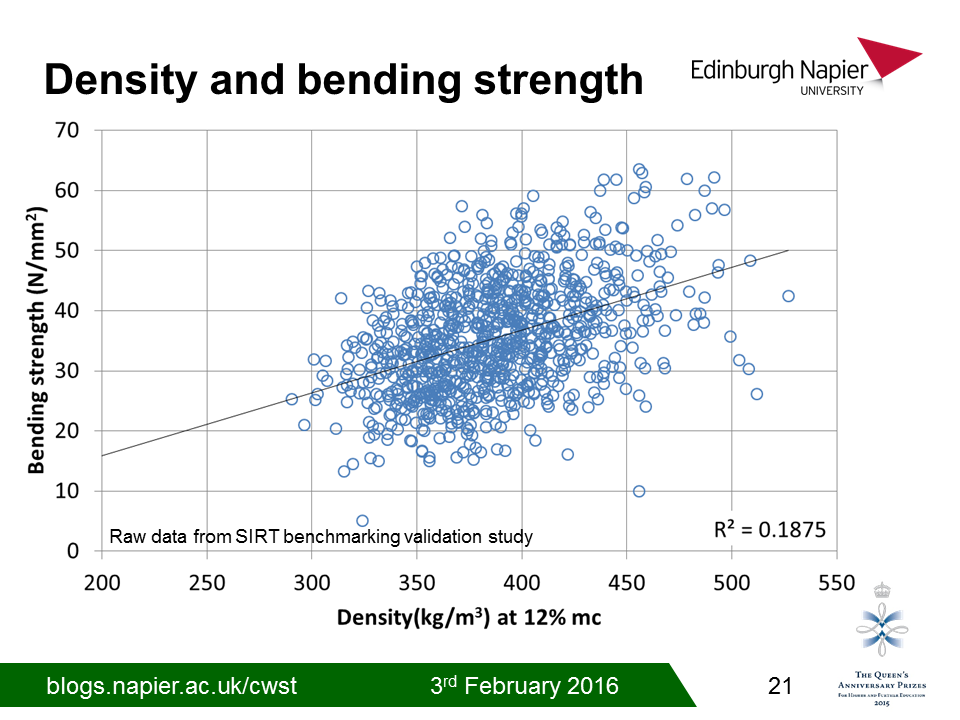
It gets even more complicated when it comes to hardwoods, where ring width and density are connected in more complicated ways – and the relationship may actually work in the other direction (wide ring means denser wood for some species). (See here for more information)
So do faster grown conifers mean lower quality timber?
A bit, but in ways that aren’t necessarily the ones you’d expect – and often the opposite is true.
A faster growing conifer would reach sawlog size at a younger age, meaning that, proportionally, the inferior core (juvenile) wood is relatively larger. But here we are talking about big differences in rotation length – a few more years won’t make a difference.
The size of the juvenile core can be influenced by forest management – and ideally there should be slow growth in the first few years, and then fast growth afterwards – making the corewood a smaller proportion of the sawlog for the same rotation length. Fast growth is desirable once the better quality wood is being produced – so long as it doesn’t result in other undesirable things like poorer stem form.
“Uni-nodal” conifer species like Sitka, normally produce one distinct whorl of branches in a growing season, along with a number of (typically smaller) inter-whorl branches. The frequency of knot clusters that are associated with branch whorls will depend on the distance between these whorls, which in turn is related to yield class. On low yield class sites the average distance between whorls is smaller than on more productive sites. This could mean that a slower grown tree produces timber with more frequent knots – reducing the timber quality.
Site also plays an important role. Poor sites can mean both slower growth and poorer quality timber. For example, with Sitka, the yield class tends to be lower on higher ground – linked to deceased temperature and greater wind. Wind exposure also causes poorer stem form (less straight grain in the timber) and greater incidence of compression wood – which is detrimental to sawn timber quality.
So the rate of growth of the tree matters for timber quality when it comes to rotation length – but there are other factors that both slow the growth of the tree – and cause poorer timber quality.
And remember, you cannot infer the growth rate of the tree from the simple rate of growth (ring width)


Dear Sir/Madam,
I work in the wood fuel business (biomass heating).
Do you have or know of any data showing rate of growth in terms of mass/year over say 25 year period for a particular tree type e.g. Sitka Spruce. I guess what I’m looking for is how the MAI varies each year typically. Any help greatly appreciated.
Hi Robin – sorry for this *extremely late* reply. Your comment was buried by a mountain of spam.
What you are describing is often called a growth curve or a growth model. There are tables and graphs for certain species according to yield class.
See for example: https://www.forestresearch.gov.uk/research/forest-yield-a-handbook-on-forest-growth-and-yield-tables-for-british-forestry/